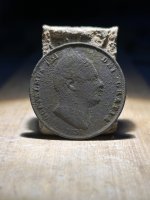Old Bookaroo
Silver Member
- Dec 4, 2008
- 4,318
- 3,510
2.0: My apologies! I did not spell Lieut. Emmet's name correctly in the original title of this post.
In John D. Mitchell's Lost Mines of the Great Southwest; Including Stories of Hidden Treasures (Mesa, Arizona: 1933).
there is the following account:
Nearly twenty years ago a man named Adams with seven others came from California into Arizona prospecting. They stopped at Camp Apache for rations and continued east. A few days march from Apache they found a great deal of gold in a small canyon. One of the men, a German, after working about ten days, became alarmed about the Indians and left, carrying about ten or twelve thousand dollars in gold as a result of his labor. This is shown by the books of the Post Trade at Fort Yuma who bought the gold from him.
The remainder of the party built a cabin and continued work till rations were low, when all but two, Adams and another man, started back to Camp Apache for supplies. The gold they had already mined was buried under the floor of the cabin.
Adams and his companion waited till they thought the others should have returned when becoming quite alarmed at their long absence, they started in search of them.
Looking back from the mountains on which they were climbing they saw the cabin in flames and their comrades, who had come in from another direction being massacred by the Indians. They concealed themselves till after dark and escaped.
- From a letter of Robert T. Emmet, then 2nd Lt. of Ninth Cav., U.S.A. Dated March 5th, 1882.
I recently contacted the National Archives and asked if they had this document. They were kind enough to reply - an excerpt from that letter follows.
"This is reply to your request which we received on June 1, 2011, concerning Robert T. Emmet's letter, 'Gold on the Black River' dated March 5, 1882.
"Based on the information you provided to us, we examined the series, 'General Index to Names and Subjects 1789-1889' (entry 291), in Record Group [RG] 77, Records of the Office of the Chief of Enginners, but were unable to find reference to Robert T. Emmet or the Black River. In addition, we also checked our automated Archival Research Catalog (ARC), under both terms, but again were unable to locate mention of either.
"It is possible that we may have pertinent records in our custody; however, without an exact location locating this letter may prove to be difficult as any further researching will likely require in-depth research, which we do not provide..."
I am quite interested in locating the entire letter. Unfortunately, this attempt was fruitless. Any suggestions will be quite welcome!
Good luck to all,
~The Old Bookaroo
In John D. Mitchell's Lost Mines of the Great Southwest; Including Stories of Hidden Treasures (Mesa, Arizona: 1933).
there is the following account:
Nearly twenty years ago a man named Adams with seven others came from California into Arizona prospecting. They stopped at Camp Apache for rations and continued east. A few days march from Apache they found a great deal of gold in a small canyon. One of the men, a German, after working about ten days, became alarmed about the Indians and left, carrying about ten or twelve thousand dollars in gold as a result of his labor. This is shown by the books of the Post Trade at Fort Yuma who bought the gold from him.
The remainder of the party built a cabin and continued work till rations were low, when all but two, Adams and another man, started back to Camp Apache for supplies. The gold they had already mined was buried under the floor of the cabin.
Adams and his companion waited till they thought the others should have returned when becoming quite alarmed at their long absence, they started in search of them.
Looking back from the mountains on which they were climbing they saw the cabin in flames and their comrades, who had come in from another direction being massacred by the Indians. They concealed themselves till after dark and escaped.
- From a letter of Robert T. Emmet, then 2nd Lt. of Ninth Cav., U.S.A. Dated March 5th, 1882.
I recently contacted the National Archives and asked if they had this document. They were kind enough to reply - an excerpt from that letter follows.
"This is reply to your request which we received on June 1, 2011, concerning Robert T. Emmet's letter, 'Gold on the Black River' dated March 5, 1882.
"Based on the information you provided to us, we examined the series, 'General Index to Names and Subjects 1789-1889' (entry 291), in Record Group [RG] 77, Records of the Office of the Chief of Enginners, but were unable to find reference to Robert T. Emmet or the Black River. In addition, we also checked our automated Archival Research Catalog (ARC), under both terms, but again were unable to locate mention of either.
"It is possible that we may have pertinent records in our custody; however, without an exact location locating this letter may prove to be difficult as any further researching will likely require in-depth research, which we do not provide..."
I am quite interested in locating the entire letter. Unfortunately, this attempt was fruitless. Any suggestions will be quite welcome!
Good luck to all,
~The Old Bookaroo











